Who Painted the Blue Rider Giving Its Name to an Art Movement Also Led by the Artist?

The beginning of the 20 th century brought with it revolutions and advancements in the way art was viewed and created. Der Blaue Reiter or The Blueish Passenger Group was founded in Munich, Germany in response against "traditional" methods of fine art. Their art explored the relationships between art, music, color, and spiritualism. Even though the group was curt-lived their art and ideas contributed to the development of German Expressionism.
The Commencement Of Der Blaue Reiter
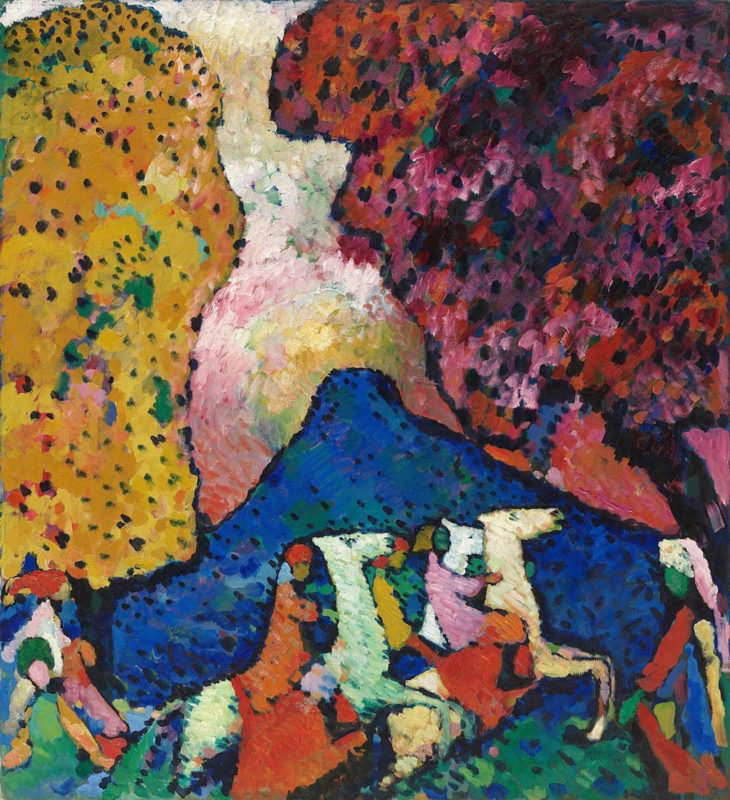
The group was founded by a blend of Russian emigrants and native German artists in 1911. Some of the group'due south most recognizable names include Wassily Kandinsky and Franz Marc who were the main members that shaped the grouping'due south overall vision. Other artists include Alexej Von Jawlensky , Gabriele Münter , Marianne Von Werefkin , August Macke , and Paul Klee . They formed the group in rejection of another German artistic motility, Neue Künstlervereinigung München (Munich New Association of Artists). They strived to create a new wave of modern fine art that separated themselves from the conventional and conformist fine art of their predecessors. They became interested in creating art that expressed emotions rather than depicting literal scenes. While each individual artist approached subject area affair and technique differently they all shared the same ideas of creating art as a connection to the spiritual through the use of color.
The Pregnant Behind The Proper name Der Blaue Reiter
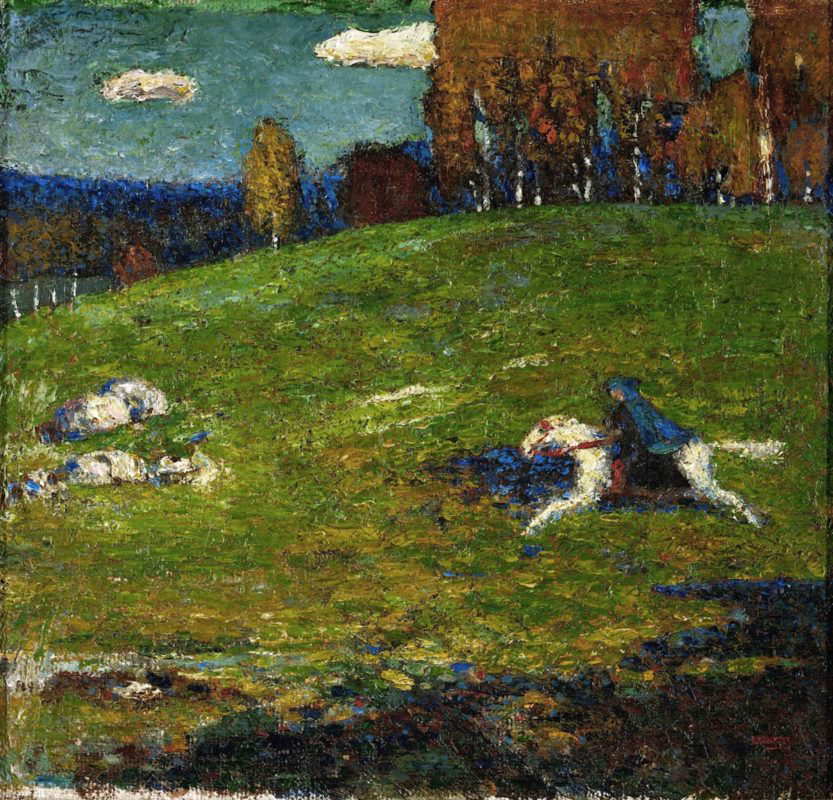
The naming of the grouping can exist simplified in that Marc liked horses and Kandinsky liked riders, and then together they created the name Der Blaue Reiter. However, there is more substance to the reason why horses, riders, and the colour meant so much to this group and contributed to their name and lasting identity.
The painting The Blueish Rider is seen every bit the painting that became the basis for the proper name of Der Blaue Reiter grouping. Kandinsky painted the image in 1903, and it is i of the beginning paintings where he transitioned into a more abstract style. The passenger in the proper name came to symbolize the transition from the physical globe to the spiritual. This thought is from the medieval Christian warriors and knights, such as Saint George, which inspired the group. The story of Saint George slaying a dragon plays a major role in the early works of Kandinsky. To them, this represented the death of the old and the birth of a beginning. The rider is the carrier of a divine awakening and a rebirth of art. The members of Der Blaue Reiter saw the materialism of their age as a block against the spiritual agreement of the mind and soul.
Are you lot enjoying this article?
Sign upwards to our Free Weekly Newsletter
Please cheque your inbox to activate your subscription
Thank you!
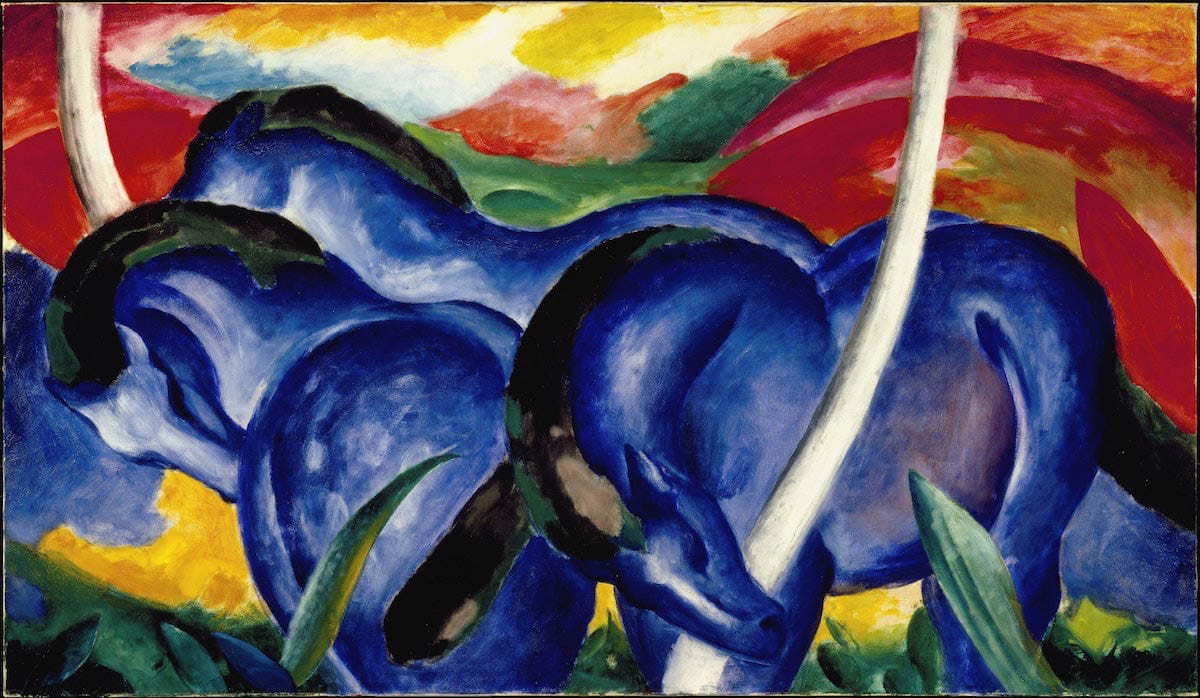
The colour blue became the literal manifestation of the transcendent and divine that these artists used in their fine art. Blue was seen as the most spiritual and calming color that is consistently seen in a variety of the group's artworks. Bluish was oftentimes used in conjunction with Franz Marc's horses as together they represent the traveling of the cloth world to a more heavenly one. Bluish is also connected to masculinity while xanthous was more feminine. Red represented the physical and natural earth compared to the otherworldliness of the color blueish. The combination of blue and the passenger represents the battle between practiced versus evil. To them, the evils of the early 20 th century were modern technologies, sciences, and urban industrialism.
The Almanac Of Der Blaue Reiter

The "Blaue Reiter" Almanac is a collection of essays, illustrations, and musical scores that has get the basis for the group'southward objectives. On the cover of the book is the group's emblem of Saint George. The first edition included 1200 copies with 50 deluxe editions that include woodcuts by Wassily Kandinsky and Franz Marc. The limited edition woodcuts titled (Bogenschütze) Archer , by Kandinsky; and Fabeltier (Fantastic Creature) , by Marc just appear in the first edition. The grouping only published this offset book equally the Commencement World War interrupted plans for a second. The volume also contains musical scores by Arnold Schönberg and Alexander Scriabin with Schönberg contributing an essay as well as sheet music for three compositions. Kandinsky'due south Yellow Sound (Der gelbe Klang) is besides included. The book contained non but images of piece of work by the group, merely other artists including Pablo Picasso , Vincent van Gogh , and Henri Matisse .

There are besides images of Medieval, Renaissance, folk-art, and not-European works of art. This included African statues, Asian ink drawings, folk fine art, and reverse glass paintings from Bavaria. The untrained artists and folk artists whose art would have been called "primitive" during that fourth dimension inspired their fine art. The unproblematic abstraction of forms and subject matter atomic number 82 members of the group to create imagery that deflected more and more from the natural earth. What makes this book important is the collaborative effort that was put into its making. Past placing images of art from a wide range of cultures, artists, musicians, and critics, it showed that all art could live simultaneously in 1 space. It shows that there is room for all types of art and how much each one influences the other.
The Influence Of Color

Color played a major function in the works of Der Blaue Reiter. As seen in the painting to a higher place, there is a clear distinction between the applications of color between different members in the same grouping. Fauvism has links to the Der Blaue Reiter group particularly with Gabriele Münter and Alexej Von Jawlensky. Like to a coloring book, they would identify color within thick, nighttime lines so it creates contrast and dimension. Jawlensky's portraits demonstrate this connection between colour and emotion. He focused primarily on the heads of figures rather than full-body portraits. He used raw bright colors in order to showcase how color tin get the essence of i's beingness.

Another inspiration came from the works of Robert Delaunay and Orphism , which would inspire August Macke and Franz Marc. They were struck by Delaunay's usage of color where it is fractured into fragments of color. Rhythm plays a huge part in this, as Delaunay believed that colors moved before one'due south vision merely as much as the natural world. This influenced Macke to paint forms that are cut into sections with very distinct angular shapes. His subjects include women in section stores, walking in parks, or groups of women in activity to which he applies this technique. Compared to Alexej Von Jawlensky, Macke uses very singled-out shapes that are almost cubist while Jawlensky uses more expressive brushstrokes freely.
Colour pushed the boundaries of expressionism equally artists used it to display the innermost spiritual feelings they felt while they painted. The usage of colors became freer and less subjected to the dullness of reality. Information technology pushed the outer limits of what was considered advisable for traditional painting. Color too played major importance for Kandinsky who used information technology in conjunction with expressing emotions with sound.
The Colour Of Music
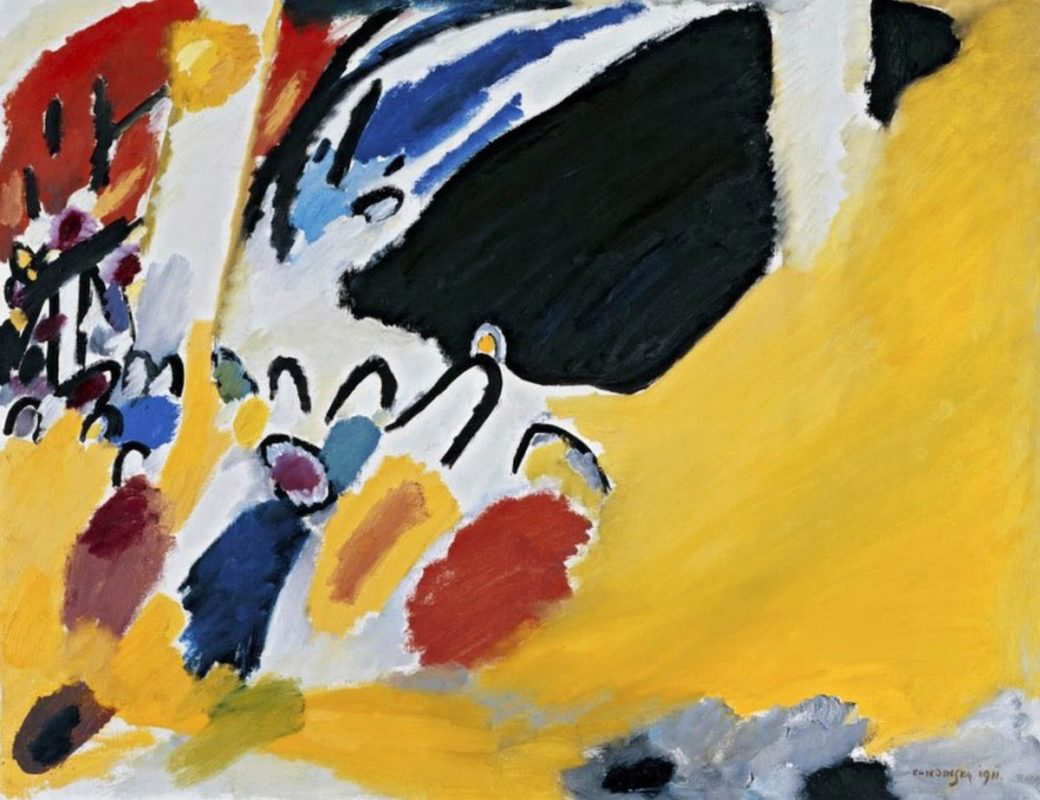
Music and its connexion to color play a key role in Wassily Kandinsky's abstruse paintings. Synaesthesia, the ability to hear, gustation, or aroma color, is a concept that introduced Kandinsky to using color as a representation of physical senses. Each color also represented unlike sections of an orchestra and together these colour combinations create a color symphony. This was also impactful on the artist Paul Klee and his development into abstract fine art. Music was likewise a big inspiration for him equally both he and Kandinsky studied music in their youth.
Kandinsky based colors with specific emotions and even instruments. His paintings are symphonies of color with each color eliciting a different emotional response. Yellow is an earthly color, and the brighter the yellow the more than chaotic and shrill feelings information technology promotes. Blue is calming and heavenly which helps to atmosphere down the yellows. Reds are powerful and dynamic which symbolize deep drums or the crescendo of trumpets. Greenish is the calmest colour, reflecting the soft tones of a violin. Violets are melancholy and are similar to the saddening music of horns or bagpipes. Finally, blackness represents the finale of a musical piece while, in dissimilarity, white is when all the other sounds go mute.
Although his paintings may seem spontaneous and announced as if Kandinsky completed it right on the spot, this is actually faux. Just like a composer arranging notes on a musical score, Kandinsky painted every bit if the notes were paint and the sail was sail music. Every color placement was intentional and it would sometimes have years for him to complete these types of musical paintings.
The Women Of Der Blaue Reiter

Inside Der Blaue Reiter there were female person artists including Marianne Von Werefkin, Gabriele Münter, Natalia Goncharova, and Clotilde von Derp. Both Werefkin and Münter played critical roles regarding the fashion and advancements they made for female expressionist artists. Both of these artists were partners with other members of the grouping: Werefkin with Jawlensky and Münter with Kandinsky during this time. Werefkin would even set dorsum her own career and champion Jawlensky equally an artist, even creating an exhibition for him. They were females within a group of men and they suffered the confines of being women. Still, they were however able to produce work that paved style for hereafter expressionist women artists.
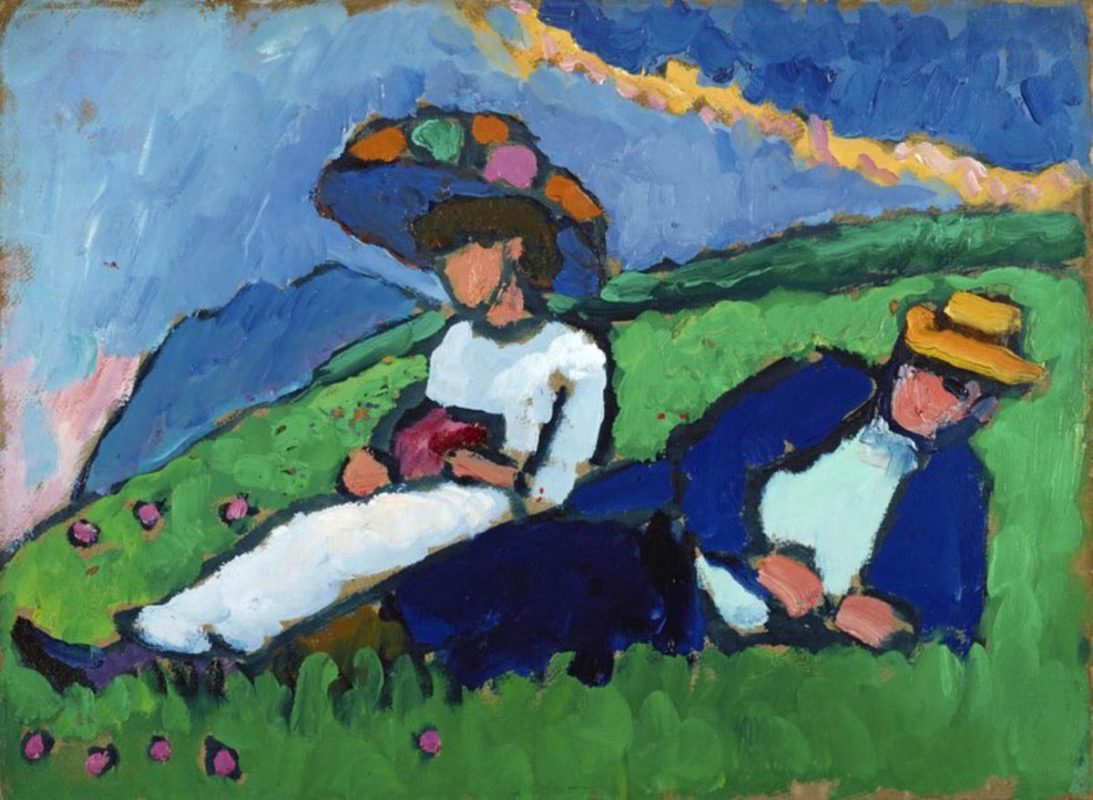
Gabriele Münter's piece of work is characterized past her use of bold colors and outlining her subjects with blackness, thick lines. Her paintings have a compacted perspective that registers equally flat to the viewer. She focuses on the color composition of her subjects filling them with vibrant colors like to the French Fauvists. Whether it is portraits or landscapes, Münter's works accept simplistic shapes that are reflective of her inspiration from traditional folk art from Bavaria and fifty-fifty children'due south paintings. She never went completely abstract like Wassily Kandinsky, just rather created figurative fine art that all the same resembled reality. This move towards a unproblematic and child-like appearance is representative of the group'due south desire to go back to creating art that was primitive. She also created still-lives with imagery of traditional Bavarian artifacts or religious iconography.

Marianne Von Werefkin's art would focus on images of women and the impoverished in her works. Her work shows the divergence in how women were represented during the beginning of the 19 thursday century. Compared to her contemporaries, she depicted women working and as hunching back confronting a backdrop of streams of colour. Her use of colour and expressive brushstrokes were influences of Edvard Munch and Vincent Van Gogh who also used colour to express the soul. She used a darker color palette with deeper tones of reds and blacks particularly for the wear of women. Werefkin showcases the women who were laborers and in the workforce during the ascension of industrialism. Her paintings combined the harsh realities of women during her era with the supernatural splendor in her landscapes.
Der Blaue Reiter'southward Simply American Fellow member

Albert Bloch is an American painter who moved to Frg in 1909. He joined the Der Blaue Reiter grouping in 1911 later on Wassily Kandinsky and Franz Marc visited Bloch'due south studio. He was the only American artist who joined the grouping. During his stay in Germany, he developed his own style only as the residual of the members did. He frequently used images of dancing harlequins, clowns playing instruments every bit well equally performing Pierrots. This was Bloch'south interpretation of how one could run into music in a visual art form. Compared to other members of the grouping, Bloch is not as widely known or recognized for his work in mod art. He eventually moved to Kansas where he taught at the University of Kansas until his retirement.
The painting higher up is an example of Bloch'southward work and his connection to Der Blaue Reiter. His Still Life 3 has no visible foreground or background and instead Bloch represents objects floating seemingly in midair. They represent the blending of boundaries betwixt the spiritual versus physical worlds. The bananas and other fruit seem to be encased in their own auras giving life to seemingly inanimate objects. His lines are very fluid and wavy which also leans to a more spiritual representation of a nonetheless life. He always retained the style and philosophy of Der Blaue Reiter even after its ultimate terminate.
The End Of Der Blaue Reiter
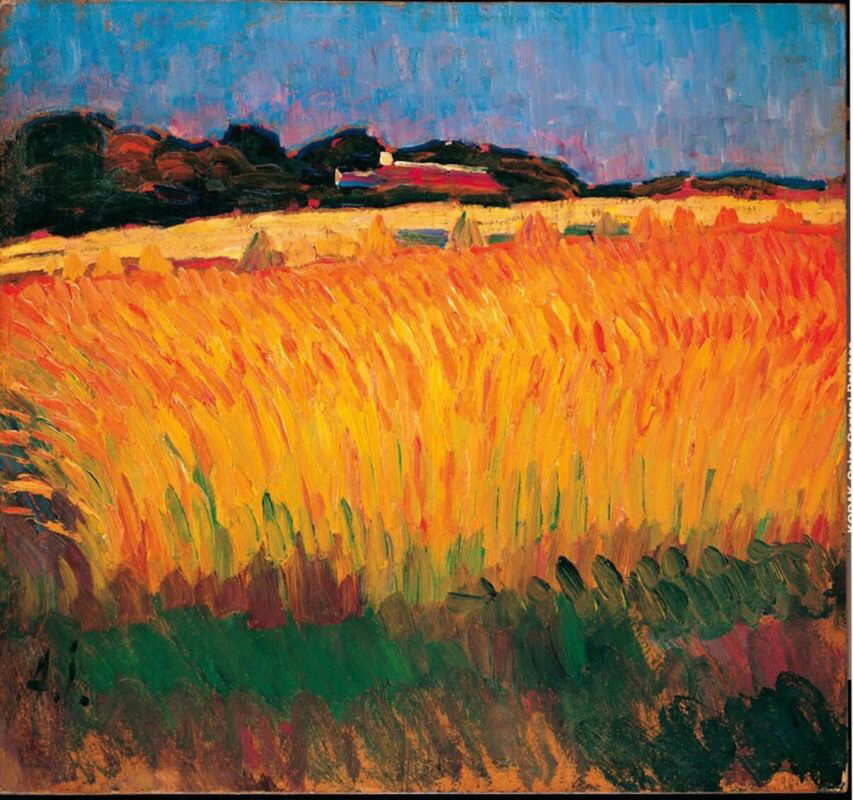
The beginning of the Kickoff Earth War was effectively the end of the group. The war engulfed Europe and the members of Der Blaue Reiter. Russian members of the group including Wassily Kandinsky, Alexej Von Jawlensky and Marianne Von Werefkin were sent dorsum to Russia because of their nationality. Both Franz Marc and Baronial Macke were drafted into the German army where, unfortunately, they both were killed.
Afterward Jawlensky moved to Switzerland and in 1924 he created the group Die Blaue Vier (The Blue Four) that included Paul Klee, Lyonel Feininger and Kandinsky. Bloch returned to the The states at the stop of Earth War I where he started a career in teaching. Almost of the works that he created in Europe were destroyed during the bombings of World War 2. He only brought back a few of his Europea paintings. They are now simply shown in his ain personal records, which include photographs of the lost paintings.
During Earth War II, modern art became a target of the Nazi government during the 1930-40s where it was considered degenerate and constitute to be an criminal offense to the regime. Münter continued to create modern art during this time even though she faced backlash and restrictions. While the Nazis would endeavour and confiscate artworks she hid her paintings as well as those of Kandinsky and her other young man Der Blaue Rider members' paintings in her own home in Murnau. During the Nazi regime Jawlensky, Klee, and other members of the group's art was taken and placed in the Degenerate Art exhibition in 1937.
Source: https://www.thecollector.com/der-blaue-reiter/
0 Response to "Who Painted the Blue Rider Giving Its Name to an Art Movement Also Led by the Artist?"
Post a Comment